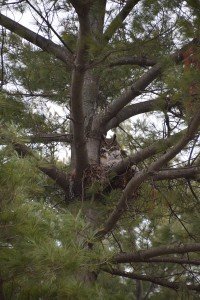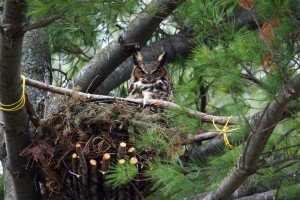By JILL BOOGREN
 A great horned owls’ nest, housing two chicks, has Nokomis area neighbors and bird lovers flocking this spring to its site near Lake Hiawatha. Onlookers watching and photographing the nest over several days were surprised to find it had fallen, only to see a human-made nest hung lower in the tree, owlets in full view. A couple of days later the replacement nest was re-attached at the original height.
A great horned owls’ nest, housing two chicks, has Nokomis area neighbors and bird lovers flocking this spring to its site near Lake Hiawatha. Onlookers watching and photographing the nest over several days were surprised to find it had fallen, only to see a human-made nest hung lower in the tree, owlets in full view. A couple of days later the replacement nest was re-attached at the original height.
(Photo right) An adult great horned owl keeps her two chicks warm in the original nest before it collapsed, likely due to wear and tear. (Photo by Jill Boogren)
It was just another day at the office for The Raptor Center staff and volunteers, who responded quickly to phone calls by passersby alerting them to baby owls on the ground.
According to Dr. Julia Ponder, executive director of The Raptor Center, it’s  common for great horned owls to use old hawk or squirrel nests that may be well constructed initially but lack structural integrity by the time owls move in.
common for great horned owls to use old hawk or squirrel nests that may be well constructed initially but lack structural integrity by the time owls move in.
(Photo left) The chicks in the temporary nest that was made by the Raptor Center before a more permanent one could be constructed. (Photo by Jill Boogren)
“They don’t do any home improvements,” said Ponder. “They may reinforce it, then lay their eggs.” This makes the nests vulnerable to wear and tear from the weather, wind, weight and a host of other factors. In this case, the nest had come down, babies and all.
 (Photo left) The owl is back in the nest with her babies after the replacement nest is raised higher with the aid of a professional arborist. (Photo by Jill Boogren)
(Photo left) The owl is back in the nest with her babies after the replacement nest is raised higher with the aid of a professional arborist. (Photo by Jill Boogren)
The owlets were fairly exposed for a couple of days when their new makeshift nest was situated on the trunk about a dozen feet up from the ground. While an adult was always in a high branch nearby, none was sitting with the owlets as before. According to Ponder, the adult owls may not come down while people are there, but they’re very attentive.
“They’ve got a lot invested in these chicks,” Ponder said. “They don’t abandon them.”
Still, it was a relief to see the adult sitting with the chicks again when the replacement nest was moved back higher. It’s a sign that the chicks still needed to be with their adults and that we humans were having an influence on their natural behavior, Ponder suggested. While these are urban owls, and likely accustomed to the sights and sounds of the city, they recognize people as predators.
“If we’re sitting there staring at their chicks that’s going to be threatening,” said Ponder.
 (Photo right) Curious neighbors and bird lovers check out the great horned owls’ nest near Lake Hiawatha. (Photo by Jill Boogren)
(Photo right) Curious neighbors and bird lovers check out the great horned owls’ nest near Lake Hiawatha. (Photo by Jill Boogren)
To lessen stress on both chicks and adults, people should keep a respectful distance. Ponder recommends using scopes or binoculars to observe from afar and to keep human activity as close to normal as possible, sticking to roads and paths and keeping dogs on leash. If owlets are on the ground—which can happen when they begin “branching” (leaving their nest)—leave them alone. The adults will be watching and will come down to feed them, but they’ll likely wait until dusk or when no one is around.
These chicks, which hatched at the end of February or first days of March, should begin “branching” at about a month old and flying at 9-10 weeks. Great horned owls stay as a family unit until late summer, gradually learning to hunt on their own before moving on.
Whatever it is that captivates us about owls and other raptors seems to be deeply personal.
“They’re so majestic. People have been fascinated with raptors all along. There’s cave art with raptors. They’ve coexisted with humans. They’re large, they have the power of flight, a piercing gaze,” said Ponder. “There’s something charismatic about them. It’s a fascination that is deep within our human fiber.”
The Raptor Center, while part of the University of Minnesota, relies on community funding and volunteers to do their work. Learn more at www.raptor.umn.edu. To report an injured raptor call 612-624-4745 during business hours, or 612-702-9924 after hours and on weekends.
Comments
No comments on this item Please log in to comment by clicking here